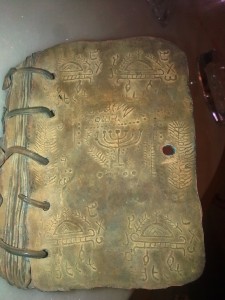I have been holding back on commenting because I am getting a bit more than irked about this story and the gross oversights by both the press and the “authorities” who are handling it. Now the Jordinian Department of Antiquities has announced that, via carbon dating, they believe that the codices they have date back to the early 1st century.
Here’s quick list of prominent voices over the Biblioblogosphere:
And here’s my two cents, some of which I repeat and endorse from other Bloggers, and some of my own observations:
Obviously they weren’t dating the plates, themselves, as you cannot carbon date lead. Why did they not use lead isotope dating? The plates are made of lead. Lead isotope dating is perfect for dating lead. Where is the disconnect?
Secondly, the more images I see of the script on the plates, the more I am convinced that it is not Hebrew or Aramaic. I’m still waiting to hear back from a few scholars who study Coptic. Perhaps now is the time to give them a poke.
UPDATE: Tom Verena has done a character chart of his own on the new images as well as analyzed the coin iconography.
Peace,
-Steve


Maybe Coptic… I see only a few characters which might resemble a ti or a shai, but both of those letters seem backwards where they might be visible. Also from the manuscripts I’ve seen (not in person, that is), the way the shai is inscribed (assuming it is a shai), with the long drop, seems to be something I’ve seen in later manuscripts or from personal correspondence (like a letter). Usually the drop is at an acute angle sharply and almost hugs the character. But, maybe. Most of the visible script doesn’t appear to be from any Coptic I’ve seen, however.
So looking at Jim’s posted pictures some more, aside from the shai (Ϣ) and ti (t), I also see what might be a fai (Ϥ), but again they are all backwards… and this id among other characters I am not familiar with.
But these are also on the same tablet as the images taken directly from the coins provided by Robert Deutsch…
I actually took a closer look over the possibility of Coptic earlier, here, because of a few characters that simply do not appear in any Hebrew or Aramaic scripts with which I am familiar:
http://aramaicdesigns.blogspot.com/2011/04/lead-codices-coptic-characters.html
I also noted that depending on which plates we’re looking at, certain characters are flipped here:
http://aramaicdesigns.blogspot.com/2011/04/lead-codices-character-sheet.html
However, these pictures are the first where I have seen the “shai/mim” character flipped.
The biggest and most nagging feature is the “rounded shin” which is so “o”- and “omega”-like. Even if the metal in the codices were dated to the 1st century, no Aramaic script until the 3rd century sported a rounded “paleo-shin”-like shin.
Nothing about it adds up.
Also, recently I’ve also come to contemplate if they are written in Judeo-Georgian, as the Georgian alphabet is another close candidate that exhibits very similar forms. However, I know even less about Georgian than I do about Coptic.
Peace,
-Steve
I hadn’t seen your analysis of the Coptic! Excellent. Yes, and I think I see other characters, but it is so random and doesn’t seem to form any actual script and it almost appears as though the author had no training at all and just merely copied script in random places. Very odd. And yes, I’m rusty on Coptic (Maybe April DeConick would be able to help here?) but I’m completely out of my element when it comes to Judeo-Georgian.
Add this post:
http://tomverenna.wordpress.com/2011/06/16/analysis-of-possible-coptic-in-new-images/